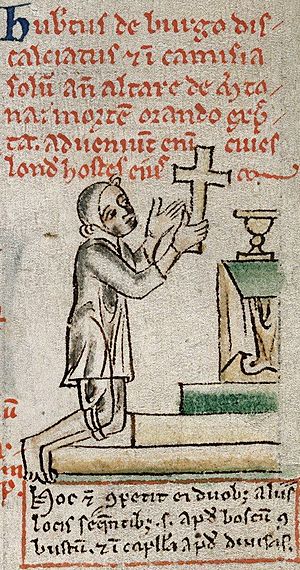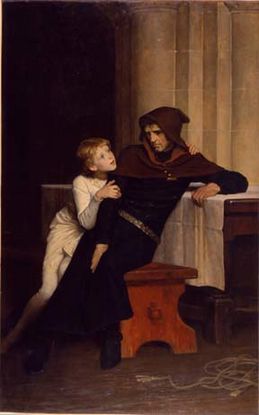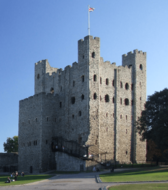Hubert de Burgh, Earl of Kent facts for kids
Quick facts for kids
Hubert de Burgh, Earl of Kent
|
|
|---|---|

Hubert de Burgh seeking sanctuary in 1234, by Matthew Paris, from his Historia Anglorum
|
|
| Chief Justiciar of England | |
| In office 1215–1232 |
|
| Monarch | John Henry III |
| Preceded by | Peter des Roches |
| Succeeded by | Stephen de Segrave |
| Justiciar of Ireland | |
| In office 16 June 1232 – August 1232 |
|
| Preceded by | Richard Mór de Burgh, 1st Baron of Connaught |
| Succeeded by | Maurice FitzGerald, 2nd Lord of Offaly |
| Lord Warden of the Cinque Ports | |
| In office 1215–1220 |
|
| Preceded by | William Brewer |
| Succeeded by | Henry of Braybrooke |
| Seneschal of Poitou | |
| In office 1212–1215 |
|
| Preceded by | Robert of Thornham |
| Succeeded by | Geoffrey de Neville |
| Personal details | |
| Born | c. 1170 |
| Died | before 5 May 1243 Banstead, England |
| Spouses | |
| Relations |
|
| Children |
|
Hubert de Burgh, Earl of Kent (born around 1170 – died before May 5, 1243) was a very important English nobleman. He served as the Chief Justiciar of England and Ireland. This was a powerful role, like being the king's main advisor and judge. He worked for King John and later for King Henry III. Because of his job, Hubert de Burgh was one of the most powerful people in English politics during the 1200s.
Contents
Hubert's Early Life and Family
Hubert de Burgh was born in Burgh-next-Aylsham, Norfolk. His family were not super rich but owned some land in Norfolk and Suffolk. Hubert inherited at least four manors, which are large estates with a main house.
He had an older brother, William de Burgh, who started a famous family in Ireland. His younger brothers were Geoffrey de Burgh, who became a bishop, and Thomas, who managed Norwich Castle. Hubert even fought alongside King Richard the Lionheart in the Third Crusade.
Hubert's Roles Under King John
Hubert de Burgh started working for Prince John around 1198. He quickly became more important in John's government. He held many different jobs.
He was a chamberlain, an ambassador to Portugal, and a sheriff in several counties. Sheriffs were like local governors. He also took care of important castles like Dover Castle and Windsor Castle. For his hard work, King John gave him more land and castles. This made Hubert a very powerful person.

In 1202, Hubert went to France to help defend a region called Poitou. He was put in charge of the big Chinon Castle. While there, he guarded Arthur I, Duke of Brittany, who was King John's nephew and a rival for the throne. Hubert bravely held the castle for a whole year. But in 1205, the French king's army captured the castle, and Hubert became a prisoner.
He was held captive until 1207. During this time, he lost some of his jobs and lands. But when he returned to England, he got new roles in King John's government. He also gained new lands across England, becoming an important baron again. From 1212 to 1215, he returned to France. He worked to help King John get back lands lost to the French king.
Becoming Chief Justiciar of England
Hubert de Burgh stayed loyal to King John during a big rebellion by the barons. This rebellion led to the signing of the Magna Carta in 1215. Hubert was one of the people who advised the king to sign this important document. The Magna Carta was a peace treaty that limited the king's power.
Soon after, Hubert de Burgh was officially named the Chief Justiciar of England and Ireland. This meant he was the king's top legal and administrative officer. He was like the chief judge and manager of the country.
During the First Barons' War (1215–17), Hubert continued to serve King John. He was in charge of areas like Kent and Surrey. He also defended Dover Castle during a long attack. He successfully kept the castle even after King John died in 1216. This was very important because it stopped the French Prince Louis from taking over England.
On August 24, 1217, a French fleet arrived to help Prince Louis. Hubert sailed out to meet them in the Battle of Sandwich. He defeated the French fleet and captured their main ship. This victory was a huge blow to Prince Louis. It made him agree to new peace talks.
Working for King Henry III
When King Henry III became old enough to rule in 1227, Hubert de Burgh was still very influential. He was made the Governor of Rochester Castle and the lord of Montgomery Castle. He also received the title of Earl of Kent. This showed how much power and trust he had.
In 1228, he was even named Justiciar for life. He was also appointed Justiciar of Ireland in 1232. However, he never actually went to Ireland for this role.
But in 1232, Hubert's enemies managed to turn the king against him. He was removed from his important job and put in prison at Devizes Castle. Later, when a nobleman named Richard Marshal rebelled against the king, Hubert was set free. He then joined the rebellion.
In 1234, the Archbishop of Canterbury helped Hubert and the king make peace. Hubert officially resigned as Justiciar. He no longer had the power of that office.
Hubert's Castles and Lands
Hubert de Burgh acquired many lands and castles during his career. In 1206, he bought the manor of Tunstall in Kent. This land was later passed down to his eldest son.
He was also made Constable of Dover Castle. This was a very important job because Dover Castle was key to defending England. He was also in charge of Falaise in Normandy, France. At Falaise, he guarded Arthur I, Duke of Brittany.
Sometime before 1215, Hubert was appointed Lord Warden of the Cinque Ports. This job involved defending important coastal towns. It also meant he was in charge of Dover Castle.
After 1215, King John gave Hubert lands in Hadleigh. Hubert started building a castle there. He got permission to build the castle in 1230, after it was already finished. However, after he fell out with King Henry III, he lost Hadleigh Castle. The castle became royal property. Today, its ruins are cared for by English Heritage.
Hubert's Marriages and Family
Hubert de Burgh married three times. His first wife was Beatrice. They had two sons, John and Hubert.
His second wife was Isabella, Countess of Gloucester. She was the daughter of an Earl.
His third wife was Princess Margaret. She was the sister of King Alexander II of Scotland. With Margaret, he had a daughter named Margaret. This daughter married Richard de Clare, 6th Earl of Gloucester.
Hubert's Death
Hubert de Burgh died in Banstead, Surrey, in 1243. He was buried in a church in London called Black Friars.
His sons did not inherit his title of Earl of Kent. This was because the title was meant only for children he had with his third wife, Princess Margaret. This might have been because King Henry III gave him the title partly due to his marriage to a Scottish princess.
Hubert in Stories and Plays
Hubert de Burgh is a character in Shakespeare's play King John. He has also been played by actors in movies and TV shows. These include the silent film King John (1899) and the BBC TV series The Devil's Crown (1978). John Thaw played him in a BBC Shakespeare version of King John (1984). A book called The Marriage of Meggotta (1979) tells the story of his daughter's marriage.
See also
- House of Burgh – a powerful family that started in 1193



